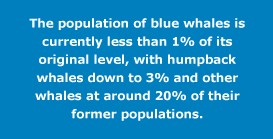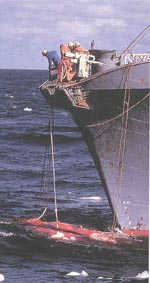|
|
|
|
Farewell whales ? Just as mining Antarctica's resources led to a great many debates, the protection of cetaceans, and in particular the whales that live in the southern waters, has also been a hot topic. There is, however, an essential difference between the two problems. The first was resolved in favour of protecting the Antarctic environment (Madrid Protocol, 1991), while the other still doesn't know whether the protection policy implemented from 1946 onwards - or management, we should say - has managed to save certain species in the process of becoming extinct. Antarctica or not, cold waters or not, whaling is an old, old story: we can all conjure up images of the many drawings and watercolours depicting feverish fishermen, standing up in fragile-looking boats, in the process of harpooning monsters thrashing about just metres away from them. Until the Norwegian Sven Fovn developed the harpoon gun between 1864 and 1868, whaling in the southern seas was not too deadly. But as man gradually discovered the countless things he could implement to attack these great cetaceans and when the first factory-ships were built after the first world war - which enabled the whalers to cut up their catch on the spot - he has begun a frantic hunt for whales across all of the world's seas, including the Antarctic waters. In 1920, 12,000 whales were killed; in 1931, out of the 44,000 whales caught, 30,000 blue whales were harpooned in the waters off Antarctica; in 1938, the whalers broke all records with 54,835 of these marine mammals being killed. After the second world war, whale experts realised that 5 years with the whaling industry at a standstill had not been sufficient for whale numbers to recover; so urgent action was required at the risk of compromising whaling itself. Which is how the International Whaling Commission (IWC) came into being in 1946, under the auspices of the United Nations; the aim of this body was to come up with recommendations and suggestions regarding whaling activities and catch quotas, although it had no resources for taking effective measures or imposing its decisions. Initially, the IWC, which was principally interested in whaling in Antarctic waters, did not fulfil its role as a regulator, with the representatives of the whaling countries sitting on the IWC often being shareholders in the whaling companies themselves... When, in the 1970s, the environmental movement was born, it criticised the Commission for the way it was managing the whaling industry and for the growing scarcity of large whales, rather than really putting forward an international policy aimed at protecting a species of animal that was in the process of becoming extinct. You only have to look at the evidence: some species of whale have disappeared almost entirely. In fact, it is estimated that the population of blue whales is current less than 1% of its original level, while humpback whales are at 3% and other types of whale are Added to this rather sombre picture are the effects of chemical pollution. All of the whales tested in the waters off Greenland were found to be contaminated with chemical synthesis compounds. Although studies into the role played by chemical synthesis in the decline of some animal populations are still at the very early stages, it appears certain in any event that it is large marine mammals and marine life in general that are the most susceptible to this type of pollution. The oceans, of course, are the final destination for long-lasting organic pollutants; we now know that the body tissue of most of the animals that have died as a result of collective beachings (something observed since the 1980s) contain high concentrations of polychlorinated biphenyl (PCB) and other chemical synthesis compounds have also been detected. PANEL The population of blue whales is currently less than 1% of its original level, with humpback whales down to 3% and other whales at around 20% of their former populations.
|


 at around 20% of their former populations. Which is why the greens did not hesitate to point the finger at those nations (Norway, Russia, Japan, and others) that at the time were still organising a veritable slaughter of whales. In 1982, the IWC voted by 25 to 7, with 7 abstentions, for a moratorium according to which all commercial whaling would cease four years later; however, this ban only affects around ten species (the biggest) out of the 80 still in existence. Three years ago, the IWC proposed to its members that the whole of the southern seas below 40° latitude south, should be permanently elevated to the rank of international sanctuary and that no more commercial whaling for large cetaceans be allowed there. Out of the 32 member countries, 23 voted in favour, 6 abstained (China, Dominican Republic, Grenada, Korea, St Vincent, Solomon Islands), 2 did not vote (Norway and St Lucia) and 1, Japan, voted against. Under the guise of pseudo-scientific motives and despite international protest, Japan still continues with its deadly whaling activities in southern waters.
at around 20% of their former populations. Which is why the greens did not hesitate to point the finger at those nations (Norway, Russia, Japan, and others) that at the time were still organising a veritable slaughter of whales. In 1982, the IWC voted by 25 to 7, with 7 abstentions, for a moratorium according to which all commercial whaling would cease four years later; however, this ban only affects around ten species (the biggest) out of the 80 still in existence. Three years ago, the IWC proposed to its members that the whole of the southern seas below 40° latitude south, should be permanently elevated to the rank of international sanctuary and that no more commercial whaling for large cetaceans be allowed there. Out of the 32 member countries, 23 voted in favour, 6 abstained (China, Dominican Republic, Grenada, Korea, St Vincent, Solomon Islands), 2 did not vote (Norway and St Lucia) and 1, Japan, voted against. Under the guise of pseudo-scientific motives and despite international protest, Japan still continues with its deadly whaling activities in southern waters.